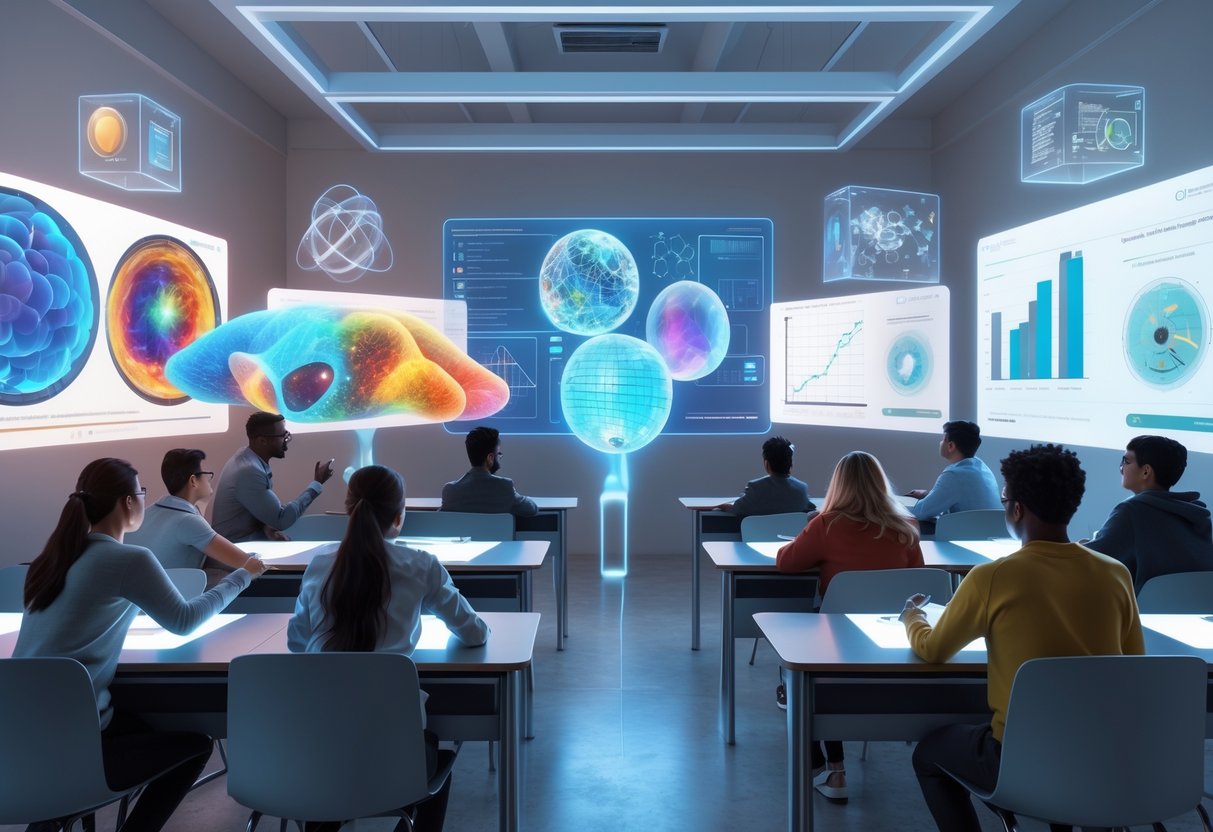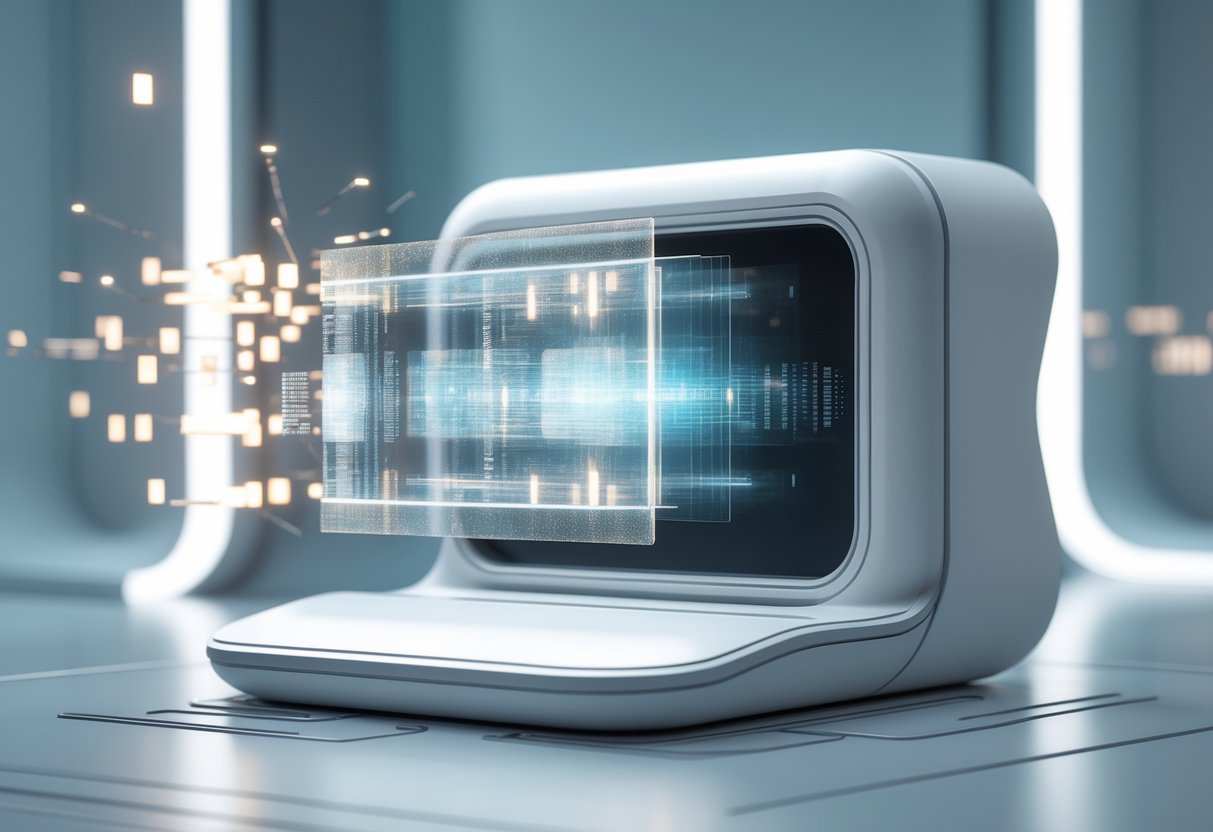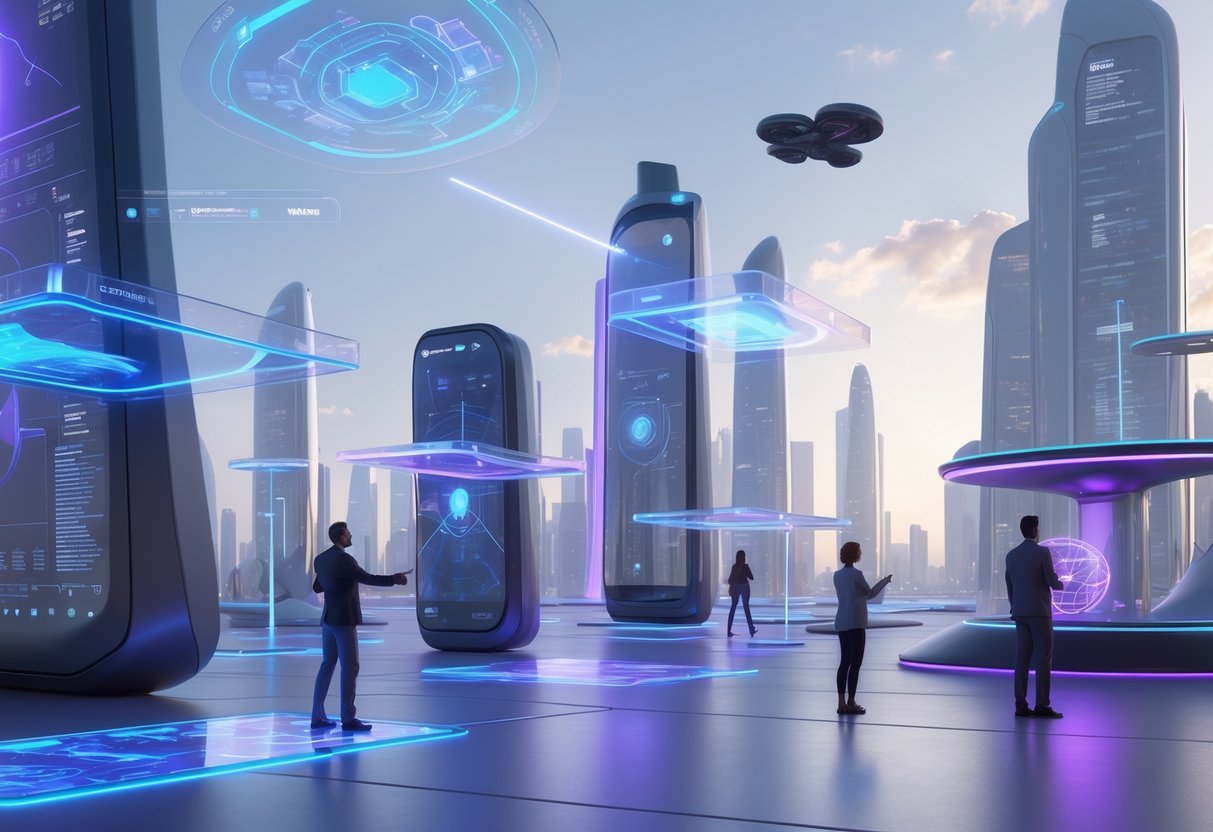Holographic Displays: The Future of Immersive Visual Technology
Updated On: November 13, 2025 by Aaron Connolly
Core Principles of Holographic Displays
Holographic displays use light interference patterns to make genuine 3D images that seem to float in the air—no glasses needed. Instead of just showing flat pictures, these systems actually capture and recreate the depth our eyes expect.
What Are Holographic Displays?
A holographic display projects light patterns into space to build up 3D images. You don’t need special glasses or headsets—just your own eyes.
The core tech relies on holograms to store visual info. Inside each hologram, you’ll find data about how light bounces off real-world objects.
When you look at a holographic display, each eye catches a slightly different angle of the same object. That’s what tricks your brain into seeing depth and movement.
Key features:
- No glasses needed
- True 3D depth
- Multiple viewing angles
- Volumetric image projection
Most holographic displays use laser light for precision. This coherent light forms the crisp interference patterns required for sharp 3D images.
Working Mechanisms of Holography
Holography works by using light interference. It captures how light waves overlap and interact.
The process starts with a laser, which splits into a reference beam and an object beam. The object beam bounces off whatever you’re recording.
Meanwhile, the reference beam heads straight to the recording medium.
How it works:
- Object beam reflects off the subject.
- Reference beam travels directly.
- Both beams meet at the recording surface.
- Their light waves create interference patterns.
- These patterns store the 3D info.
Spatial light modulators step in to control the light during playback. They change the phase and amplitude of light beams electronically.
When you want to see the hologram, laser light passes through the stored interference pattern. This brings back the original light waves that bounced off the object.
Your brain interprets these patterns as a 3D image—with real depth and perspective.
Differences from Traditional Displays
Traditional displays show flat images, maybe with some fake depth tricks. Holographic displays actually create 3D light patterns right there in space.
Standard screens rely on pixels for color and brightness. Each pixel only gives you one angle.
Holographic displays store multiple viewpoints at once. So, if you move, you’ll see the image shift naturally.
| Feature | Traditional Display | Holographic Display |
|---|---|---|
| Viewing angle | Limited | 360 degrees |
| Depth perception | Simulated | True 3D |
| Glasses needed | Often required | None |
| Image location | On screen surface | Floating in space |
Traditional 3D displays often leave your eyes tired because they try to fool your vision. Holographic displays just work with how we naturally see.
Resolution needs are wildly different. Traditional screens care about width and height, but holographic ones must encode depth too, which means a lot more processing.
With holographic displays, you can walk around the image and see it from different sides. Flat screens just can’t do that.
Advancements in Hologram Technology
Lately, hardware and software leaps have taken holographic displays from science experiments to real-world tools. We’re seeing massive jumps thanks to better spatial light modulators, tinier parts, and way sharper images.
The Role of Spatial Light Modulators
Spatial light modulators sit at the heart of today’s holographic displays. They shape light waves to make the interference patterns that create 3D images.
The newest modulators work way faster than before. They can switch thousands of times each second, letting us make moving holograms instead of just static ones.
Liquid crystal on silicon (LCoS) modulators have raised the pixel count. More pixels mean crisper holograms with finer detail.
Some systems now squeeze in over 4,000 pixels per inch.
Digital micromirror devices take another route. These tiny mirrors flip rapidly to steer light, and they’re more durable than liquid crystal options.
Modern modulators also handle color much better. Multi-wavelength systems project red, green, and blue at once, so you get full-colour holograms instead of boring single-color ones.
Miniaturisation and Component Innovation
Shrinking holographic systems has become a huge priority. Early versions filled entire rooms, but now you can find devices that fit on a desk or even in a backpack.
Laser diodes have gotten tiny and more powerful. New semiconductor lasers are 90% smaller than older ones, use less energy, and make cleaner light.
Compact optical systems now do several jobs on one chip—light generation, modulation, projection—all packed together. That’s helped bring down both size and cost.
Micro-electromechanical systems (MEMS) have shaken up how we create holograms. These microscopic mechanical bits move light beams with crazy precision.
They’re thousands of times smaller than old-school mirrors.
HoloConnects and other companies have built portable gear like the Holobox. It captures people against a white background and projects them as 3D holograms. The whole setup fits in a box about the size of a big TV.
Breakthroughs in Resolution and Colour
Image quality has taken a huge leap with better resolution and color accuracy. Some modern holographic displays look just as sharp and vibrant as high-end flat screens.
4K resolution holograms have become the standard in pro systems. A few experimental displays even push 8K. With higher pixel counts, you can spot tiny details like facial expressions or the weave of fabric.
Color’s improved too, thanks to better lasers. New setups use several laser wavelengths to show a wider range of colors, including shades older systems just couldn’t manage.
Brightness has gone way up. Now, holographic projectors can make images you’ll see clearly in a regular room. In the past, you needed a pitch-black space.
Advanced chips handle all the number crunching for real-time holograms. Graphics processors built for gaming now power these displays, making dynamic, interactive holograms much more affordable.
AI-powered enhancement steps in to boost image quality. These systems study the original subject and fill in missing bits, making holograms look smoother and more realistic.
Immersive Experiences and User Interaction
Holographic displays pull you in with depth and realism that flat screens just can’t touch. You get to interact with 3D objects in ways that feel surprisingly natural.
Depth and Realism in 3D Visuals
Holographic displays give you real depth perception that flat screens only pretend to have. Instead of faking it, these systems make digital objects float in your space.
The tech works by controlling how light hits each eye. That’s what gives you those natural depth cues and makes your brain believe the image is truly 3D.
Key advantages:
- Objects pop out at different distances
- You can focus naturally on near or far things
- Move around and see different sides of 3D models
- No glasses or headsets needed
In gaming, this means characters and worlds feel alive. For business, product demos become much more convincing when clients see true dimension.
The realism goes further with spatial audio that matches the 3D visuals.
Enhanced Viewer Engagement
Interactive holographic displays make you an active participant, not just a viewer. You can grab, rotate, and move 3D objects with your hands, which feels pretty cool.
Common ways to interact:
- Hand tracking for grabbing and moving
- Voice commands for getting around
- Eye tracking to focus on what matters
- Multi-touch surfaces paired with holographic projection
This hands-on approach keeps people engaged longer. Studies suggest we remember things better when we can actually interact with 3D models.
Real-time collaboration gets a boost, too. Multiple users can tweak the same holographic content at once—pointing, rotating, or annotating from their own angles.
It works especially well in education. Medical students can explore 3D organs, while engineers test virtual prototypes before building the real thing.
Applications in Entertainment
Holographic displays are shaking up live events and interactive content. They’re bringing back famous performers for new shows and building gaming worlds that react to you in real time.
Cinematic and Live Event Holograms
Holographic tech has changed live concerts. We’ve watched legends like Tupac, ABBA, and Michael Jackson appear on stage long after their time, and honestly, it’s a bit surreal.
Modern uses:
- Virtual performances in multiple venues at once
- Interactive product launches at events
- Theatre shows with holographic characters next to live actors
Artists can now be in several places at once. MrBeast pulled off a wild stunt, appearing as a hologram in LA while he was actually underground in New Zealand. That kind of creativity lets creators reach global fans without ever hopping on a plane.
Film and TV productions use holograms to make CGI characters that blend with real actors. It opens up new ways to tell stories and keeps audiences glued to the screen.
Gaming and Interactive Media
Gaming’s probably the most exciting place for holographic displays right now. Developers are working on games where 3D characters seem to stand right there in your room.
These systems track your hands and gestures, so you can interact directly with the holographic world.
Some cool innovations:
- Tabletop holographic games that project characters onto your table
- Gesture-controlled interfaces that react to your movements
- Mixed reality that blends the physical and digital
Museums and theme parks use holographic displays for interactive exhibits. Visitors can handle virtual artifacts or dive into science concepts through 3D projections.
The tech also lets people in different places play or work together with the same holographic content. It’s a more natural way to collaborate or game than staring at a flat screen.
Holographic Displays in Education

Holographic displays bring 3D images into the classroom, letting students see things from all sides—no glasses required. This tech turns old-school lessons into interactive learning sessions that stick with you.
Interactive Learning Environments
Holographic displays make classrooms lively and hands-on. Instead of just listening, students jump in and explore.
We can now zoom into molecules, wander through ancient ruins, or dissect virtual frogs—all in 3D.
Students team up on shared holographic simulations. Maybe they walk through ancient Rome in history or work together on a virtual science experiment.
Remote collaboration feels seamless. Students from different places join the same virtual class, sharing experiences as if they’re side by side.
Teachers can even bring in guest speakers as holograms, connecting students to experts from around the world.
The tech fits different learning styles. Visual learners see concepts in 3D, while hands-on learners can interact with models.
This personalized approach helps every student tackle tough topics more easily.
Teaching Complex Concepts Visually
When you turn abstract ideas into holograms, they suddenly make sense. DNA structures, math equations, and planetary orbits jump off the page and become interactive 3D models students can walk around and poke at.
Medical students get to study super-detailed human anatomy—no need for real bodies. Engineering students pull apart virtual engines, seeing every nut and bolt in motion. Chemistry classes come alive when students watch molecules react in real time, right in front of them.
Data visualisation gets a serious upgrade with holographic displays. Students don’t just look at charts; they stroll around floating graphs, actually seeing the story in the stats. Even tricky physics concepts like electromagnetic fields finally become visible.
This kind of visual learning really closes the gap between theory and practice. When students watch these processes unfold, they just get it faster—no more struggling to picture the invisible.
Healthcare and Medical Training

Holographic displays are shaking up how medical professionals learn and practice. These systems deliver glasses-free 3D visuals, making anatomy less confusing and training more realistic.
3D Anatomical Visualisation
Medical schools and hospitals now roll out holographic tables that show patient scans in 3D. Students can walk around a floating heart or brain, checking out every detail from any side.
Key benefits include:
- Life-sized holograms built from real patient data
- Groups can view the same 3D model at once
- No need for special glasses or headsets
Doctors use the NOVAC holographic table to spin CT scans and MRI images in mid-air. Surgeons check out tumours before operations, planning every move with more confidence.
Medical students pick up tricky concepts faster when they see organs in 3D instead of flat pictures. Professors notice students get more involved when holograms replace boring slides.
Some hospitals bring in specialist doctors as holograms for remote consults. This sends expert advice to rural clinics without anyone having to travel.
Simulations for Professional Training
Holographic tech now lets students practice on virtual patients, sidestepping the ethical issues of using real bodies. These 3D projections react to what students do, almost like real people.
Training applications include:
- Practicing surgical procedures
- Building diagnostic skills
- Running emergency response drills
- Exploring anatomy hands-on
The HoloCare consortium, spread across several countries, builds holographic tools for training surgeons and finding tumours. Medical schools save a lot compared to running cadaver labs.
Students can repeat procedures on holographic patients as many times as they want. This practice helps build confidence before they work on real people.
Trainees use hand gestures to interact with floating 3D models—no VR headsets required. That keeps costs down and makes it easier for more schools to join in.
Collaboration and Communication

Holographic displays are changing how we work together. They create immersive experiences that actually make remote team members feel like they’re in the room. Teams and colleagues interact with 3D content in real time, no matter where they are.
Remote Collaboration Tools
Modern holographic tools let teams tinker with shared 3D models together. Microsoft HoloLens 2 leads the way, working with Teams to show colleagues as life-sized holograms.
Key features include:
- Editing 3D models together in real time
- Shared virtual workspaces
- Compatibility across platforms
- Voice and gesture controls
Manufacturing teams gather to review product designs, pointing out parts and making tweaks on the spot—even if they’re continents apart.
Architecture firms especially love this tech. Designers can walk through virtual buildings together, changing things on the fly and seeing updates instantly.
Enterprise headsets cost £3,000–£5,000. Most companies dip their toes in with pilot programs first.
Healthcare teams use holographic collaboration to review patient scans in 3D, planning surgeries with more detail than ever.
Virtual Meetings and Conferences
Holographic meetings make regular video calls feel flat. People appear as realistic 3D projections, so eye contact and body language come through naturally.
Meeting benefits include:
- Better non-verbal communication
- Less screen fatigue
- More focus and engagement
- Realistic spatial audio
Cisco’s Webex Hologram lets presenters beam into remote locations with impressive clarity.
Event organisers are jumping on holographic displays for hybrid conferences. Keynote speakers can address multiple venues at once, giving everyone the same experience.
Quick win: Try holographic presentations before going all-in with full meetings. Attendees say they feel more engaged than with traditional video calls.
The tech supports up to 50 people at once. Still, you’ll need at least 100 Mbps for smooth meetings—bandwidth is a big factor.
Training sessions get a boost too. Remote instructors can demo complicated procedures and still keep a personal connection with learners everywhere.
Integrating Augmented Reality and Holography

When you combine augmented reality with holographic displays, you get systems that project 3D virtual stuff right into your real-world view. This mix gets rid of the eye strain you get with old-school AR by providing natural depth cues.
Merging AR with Holographic Displays
New metasurface waveguides have made it possible to build compact holographic AR into regular eyeglasses. These use inverse-designed metasurface couplers in high-index glass for precise control of light.
The breakthrough comes from lensless holographic light engines paired with special waveguides. Instead of bulky optics, these systems put phase-only spatial light modulators right onto in-coupling gratings.
Technical advantages include:
- About 78.4% see-through efficiency
- Full-colour operation (red, green, blue)
- Small size—just like regular glasses
- Consistent viewing from all angles
Manufacturers use electron beam lithography on high-index glass, avoiding the contamination problems that usually bother holographic systems.
These displays can show several depth planes at once. That means your eyes can focus naturally, solving the discomfort of flat AR displays.
Blurring Digital and Physical Worlds
Holographic AR creates virtual objects that seem to exist at real distances. You can focus on both digital and real things without your eyes getting tired.
The tech lets virtual objects hide behind real ones—so digital content blends seamlessly with your environment. These mixed-reality experiences feel surprisingly real.
Practical applications include:
- Training simulations with real depth
- Educational content floating in classrooms
- Navigation that shows directions at true distances
- Interactive 3D models for design and engineering
Current prototypes combine 360-degree holographic content with classic 2D AR. This hybrid setup uses the best of both worlds.
Because of wavefront reconstruction, displays respond naturally to head movement and changes in viewpoint. Virtual objects keep the right perspective and depth as you move around.
Driving Innovation with Artificial Intelligence

Artificial intelligence is pushing holographic displays to new levels. Machine learning algorithms now handle real-time rendering and boost display performance. These AI systems bring complex holographic projections to everyday devices and seriously improve image quality.
Machine Learning for Real-Time Rendering
Machine learning can now whip up 3D holograms instantly—even on regular hardware. MIT’s tensor holography can make high-quality holograms run on smartphones.
Old-school holographic rendering used to need loads of computing power. One image could take hours to process.
AI changes everything:
• Real-time images in milliseconds • Smartphones can handle the processing • Automatic depth calculation • Scenes update dynamically
Neural networks learn from thousands of training images. They predict how light should behave to create lifelike 3D effects.
These networks figure out depth, lighting, and perspective by themselves. Programmers don’t have to code all the physics anymore.
We’re already seeing real uses. VR headsets rely on AI holography for lighter displays. Medical imaging systems now create instant 3D scans.
AI-Optimised Display Algorithms
AI fine-tunes holographic displays with camera-in-the-loop learning and adaptive algorithms. These systems calibrate themselves to deliver crisp images.
Stanford researchers use AI to improve displays that use LEDs. The algorithms learn from feedback and fix distortions on the fly.
Key optimisation areas:
• Colour accuracy across all wavelengths
• Uniform viewing angles
• Dispersion correction
• Consistent brightness
Machine learning models watch display performance in real time. They tweak settings automatically when lighting or conditions change.
Cameras show the system what good holograms should look like. The AI compares and keeps getting better.
Quality jumps up with these systems. Images look sharper and power use drops, thanks to smart resource management.
Challenges and Limitations

Holographic displays still have some big hurdles—especially when it comes to power consumption and cost. These issues slow down how fast the technology can go mainstream.
Power Consumption Issues
Modern holographic displays eat up a ton of energy. Creating 3D images takes way more power than regular screens.
Powerful computers have to generate the complex light patterns. They run constantly, processing all that visual data. Users end up with higher electricity bills.
Miniaturisation just makes things harder. Smaller devices can’t fit big batteries, but they still need a lot of juice to make holograms.
Most holographic displays plug into wall power. Portable models only last 2–3 hours on a charge, so you can’t take them far.
Research teams are working on more efficient chips. New processors could cut power use by 40% in five years. Still, holographic displays will probably always need more energy than regular screens.
Accessibility and Cost Factors
High prices put holographic displays out of reach for most people. Pro systems cost £50,000–£200,000. Even the cheapest consumer models start at £5,000.
Making these displays requires pricey materials and precise gear. The special optics aren’t mass-produced yet, so prices stay high compared to LCD or OLED screens.
Technical limitations get in the way, too. You have to stand in the right spot to see holograms clearly. Room lighting matters. The setup can be a hassle for home users.
Learning to use holographic systems isn’t always easy. Many require technical know-how, which keeps casual users away.
Analysts expect prices to drop as production ramps up. By 2027 or 2028, we might see consumer models under £1,000.
The Future Landscape of Holographic Displays

Holographic displays are moving fast—from lab experiments to real-world tools. Machine learning now lets computers process holograms almost instantly. This tech could show up everywhere, from hospitals to retail stores and classrooms, within the next decade.
Upcoming Trends and Developments
Artificial intelligence integration is the biggest game-changer in holographic displays. Machine learning is making real-time holographic experiences possible.
Neural networks now handle image rendering automatically. Displays adjust to different lighting and angles without anyone fiddling with settings.
Enhanced parallax detection boosts depth perception. New systems track eye movements more accurately, updating images based on what you’re actually looking at.
Key improvements on the way:
- Expanded eyeboxes for wider viewing angles
- Advanced eye tracking for smoother adjustments
- Sharper spatial light modulators for better image quality
- Improved luminance tools for safer viewing
Lower costs are speeding up adoption. Better manufacturing is making holographic displays more affordable for businesses—and eventually, for all of us.
Potential for Everyday Use
Healthcare applications lead the way in mainstream adoption. Surgeons use holographic displays for 3D medical imaging during operations. Medical training programs also rely on them for anatomy education.
Retail environments have started using holographic product demonstrations. Customers check out 3D models from all angles without touching anything.
I’m pretty sure we’ll see holograms everywhere within five to ten years in a bunch of industries.
- Architecture firms can use holograms for client presentations.
- Automotive showrooms might display virtual car models.
- Educational institutions could teach tough concepts with 3D visualisation.
- Gaming and entertainment venues are already offering immersive experiences.
Home adoption still has some hurdles. High costs and technical complexity make things tricky right now. But simpler, more affordable versions are on the horizon, and we might see them in homes by 2030.
Engineers and designers need to tackle a few challenges first. Lowering power consumption, boosting brightness, and making interfaces that feel easy for everyone—not just techies—will push this tech forward.
Frequently Asked Questions

People have a lot of questions about using holographic displays in real life. Everything from setting up systems for events to tracking down the right gaming plugins comes up.
These questions touch on installation costs, event integration, and the latest tech updates.
How can one integrate holographic display technology into a live event setting?
If you want to use holographic displays at live events, you’ll need to plan carefully and set up the right equipment. A darkened environment and smart positioning create the strongest visual impact for your audience.
First, pick between fan-based displays and projection systems. Fan displays suit smaller venues and make 3D images float in mid-air. Projection systems fit bigger spaces but need a more involved setup.
Set up your holographic display at eye level for the best results. Keep the lighting low so the hologram looks sharp and bright.
Most systems connect with HDMI or USB, so you won’t need any wild custom hardware. They play nicely with standard presentation gear.
Plan your content ahead of time. Simple animations and clear messages usually work better than complicated visuals.
Test everything before the event. You really don’t want technical glitches in front of a crowd.
What are the typical costs associated with installing a holographic display system?
Entry-level holographic display systems start at about £500. These small fan-based units work for retail or smaller events and create basic 3D effects.
Mid-range systems cost between £2,000 and £10,000. You get better image quality and larger display areas, making them great for trade shows, museums, or business presentations.
High-end setups can run £50,000 or more. These offer cinema-level holograms, gesture controls, and multiple viewing angles. You’ll mostly find them in theme parks, big retail spaces, or research labs.
Don’t forget the ongoing costs. Content creation ranges from £200 for simple animations to over £5,000 for complex, interactive experiences. Maintenance and software updates usually add about 10-15% of the upfront cost each year.
What steps are involved in setting up a holographic display for a Minecraft server?
To set up holographic displays in Minecraft, you’ll need to install a plugin on your server. HolographicDisplays is the most popular and works with Spigot and Paper servers running Java Edition.
Grab the HolographicDisplays plugin from the official Spigot page. Upload the .jar file to your server’s plugins folder, then restart the server to get it running.
You’ll want a permissions plugin like LuckPerms to manage who can create holograms.
Use /hd create [name] [text] to make your first hologram. Stand where you want it to appear before running the command. Add more lines with /hd addline [name] [text].
Customise your holograms with colour codes and formatting. Try &c for red text or &l for bold. You can even add item displays with /hd addline [name] ICON: DIAMOND to show floating items.
Can you recommend some of the best plugins for enhancing holographic displays in gaming?
HolographicDisplays is still the go-to for Minecraft servers. It’s free, gets regular updates, and handles both static and animated displays. Even with thousands of holograms, it won’t drag your server down.
DecentHolograms brings similar features but runs more efficiently. It comes with built-in animations and uses fewer resources, which is great for busy servers.
If you want extra features, check out HoloMobHealth for mob health bars or ChestCommands for holographic menus. They integrate smoothly with core hologram plugins.
PlaceholderAPI is a must if you want dynamic content. It lets you show player stats, server info, or real-time data that updates automatically. Most modern hologram plugins support PlaceholderAPI right out of the box.
What advancements have been made in 3D holographic display technology recently?
Lately, developers have focused on better image resolution and lighter materials. Now, holographic displays can hit 4K resolution and shine bright enough for normal lighting—not just dark rooms.
Upgraded processing power means real-time hologram generation is finally possible. New graphics cards can render complex 3D scenes instantly, so interactive holograms respond to gestures and movement.
Healthcare has seen some big breakthroughs. Surgeons now use holographic displays to see patient scans in 3D during operations. This helps boost surgical precision and patient outcomes.
Manufacturing costs have dropped fast. What used to cost £100,000 five years ago now sits closer to £20,000 for similar features. This price drop makes holographic displays way more accessible for smaller businesses and schools.
How does one go about finding and downloading reliable plugins for holographic displays?
Start with official plugin repositories like Spigot Resources or CurseForge if you’re looking for Minecraft holographic plugins.
These platforms usually verify uploads, which adds a bit of peace of mind. Plus, you’ll find user reviews that can point you in the right direction.
Always check when the plugin was last updated. If a plugin hasn’t seen any love in over six months, it’s probably best to skip it.
Old plugins might break with newer server versions, or worse, they could have security holes.
Read through the user reviews and poke around to see what kind of reputation the developer has. I always trust plugins with active support forums and developers who actually respond when something goes wrong.
Popular plugins like HolographicDisplays have big communities, so you can find help and tutorials without much hassle.
Test every plugin on a development server first. Seriously, don’t just toss it on your live server and hope for the best.
Make backups before you add anything new. After installation, keep an eye on server performance to catch any weirdness early.

